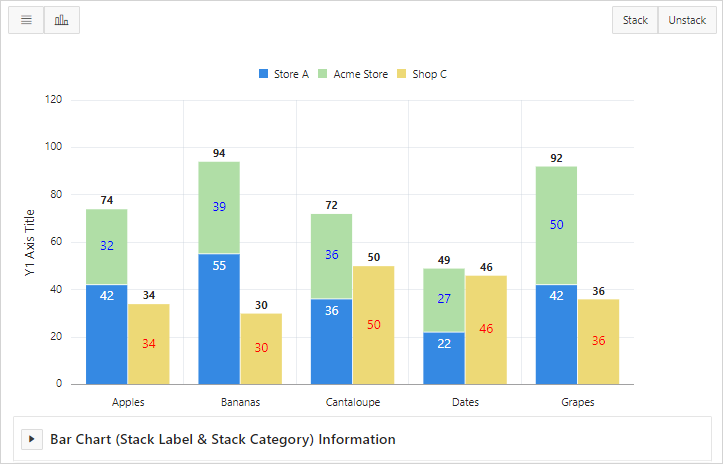11.4 Creating Charts
You can add a chart by running a built-in wizard or creating it manually in Page Designer.
- About Supported Charts
App Builder supports two types of charts: Charts (based on the Oracle JavaScript Extension Toolkit (Oracle JET) Data Visualizations) and legacy AnyChart Charts. - Sample Charts
Developers can view chart examples by installing the Sample Charts sample application. - Adding a Chart on a New Page Using a Local Database
Add a chart on a new page using a local database: - Adding a Chart on a New Page Using External Data Sources
Run the Create Page Wizard to add a new page with a chart using an external data source. - Adding a Chart in Page Designer
Add a chart by creating it manually in Page Designer. - Editing Charts
You can alter how a chart displays by editing chart attributes in Page Designer.
See Also:
Parent topic: Managing Database Application Components
11.4.1 About Supported Charts
App Builder supports two types of charts: Charts (based on the Oracle JavaScript Extension Toolkit (Oracle JET) Data Visualizations) and legacy AnyChart Charts.
App Builder supports the following charts:
-
Chart - Chart support in Oracle Application Express is based on the Oracle JET Data Visualizations. Oracle JET empowers developers by providing a modular open source toolkit based on modern JavaScript, CSS3, and HTML5 design and development principles. The Oracle JET data visualization components include customizable charts, gauges, and other components that you can use to present flat or hierarchical data in a graphical display for data analysis. Each Oracle JET visualization supports animation, accessibility, responsive layout, internationalization, test automation, and a range of inter activity features. The charts provide dozens of different ways to visualize a data set, including bar, line, area, range, combination, scatter, bubble, polar, radar, pie, donut, funnel, and stock charts..
See Also:
"Working with Data Visualizations" in JavaScript Extension Toolkit (JET) Developing Applications with Oracle JET.
-
AnyChart Chart - AnyChart chart support is based on a third party charting solution provided by AnyChart. This is a flexible Flash and JavaScript (HTML5) based solution that enables developers to create animated and compact interactive charts. AnyChart charts have been categorized as a legacy component and may be deprecated in a future release.
See Also:
"Managing Legacy Charts" and "Upgrading an Application to Include New Components"
Parent topic: Creating Charts
11.4.2 Sample Charts
Developers can view chart examples by installing the Sample Charts sample application.
The following is a sample chart from page 9 of the Sample Charts sample application.

Description of the illustration sample_charts.png
Click the Horizontal and Vertical to toggle between a horizontal or vertical display. Click Stack and Unstack to view two series of data or three series of data.
This chart displays two series of data, Store A and Acme Store, stacked and associated with the Y axis, and the third series of data, Shop C, associated with an extra Y axis and rendered as a separate chart below the other two series of data.
Expand the Bar Chart (Stack Label & Stack Category) Information region at the bottom of the page to view information on the chart.
See Also:
"Installing a Productivity and Sample App" for more information on installing the Sample Charts application
Parent topic: Creating Charts
11.4.3 Adding a Chart on a New Page Using a Local Database
Add a chart on a new page using a local database:
To add a chart on a new page:
Parent topic: Creating Charts
11.4.4 Adding a Chart on a New Page Using External Data Sources
Run the Create Page Wizard to add a new page with a chart using an external data source.
The component(s) described in this topic include built-in support for REST Enabled SQL and REST Data Sources which enables read and write access to remote data sources. In order to build a component on a remote data source, you must first create the application and configure the external data source.
Tip:
To learn more about external data sources, see "Managing REST Enabled SQL References" and "Managing REST Data Sources."To add a chart on a new page using an external data source:
Parent topic: Creating Charts
11.4.5 Adding a Chart in Page Designer
Add a chart by creating it manually in Page Designer.
To add a chart to an existing page in Page Designer:
Parent topic: Creating Charts
11.4.6 Editing Charts
You can alter how a chart displays by editing chart attributes in Page Designer.
- Editing Chart Attributes
- Switching Chart Type
- Enabling Automatic Refresh
- Using Custom JavaScript with Charts
See Also:
Parent topic: Creating Charts
11.4.6.1 Editing Chart Attributes
To edit chart attributes:
Parent topic: Editing Charts
11.4.6.2 Switching Chart Type
To switch a chart type:
Parent topic: Editing Charts
11.4.6.3 Enabling Automatic Refresh
Charts can monitor information by enabling the Automatic Refresh, Interval attribute, or by using a dynamic action with the Refresh action.
Parent topic: Editing Charts
11.4.6.3.1 Enabling the Automatic Refresh Attribute
To enable automatic refresh updates:
Parent topic: Enabling Automatic Refresh
11.4.6.3.2 Creating a Refresh Dynamic Action
To create a Refresh dynamic action:
See Also:
Parent topic: Enabling Automatic Refresh
11.4.6.4 Using Custom JavaScript with Charts
Tip:
The Sample Charts application contains a number of examples of using custom JavaScript with chart. See "Installing a Productivity and Sample App" for more information on installing sample applications.
To use custom JavaScript:
See Also:
Parent topic: Editing Charts